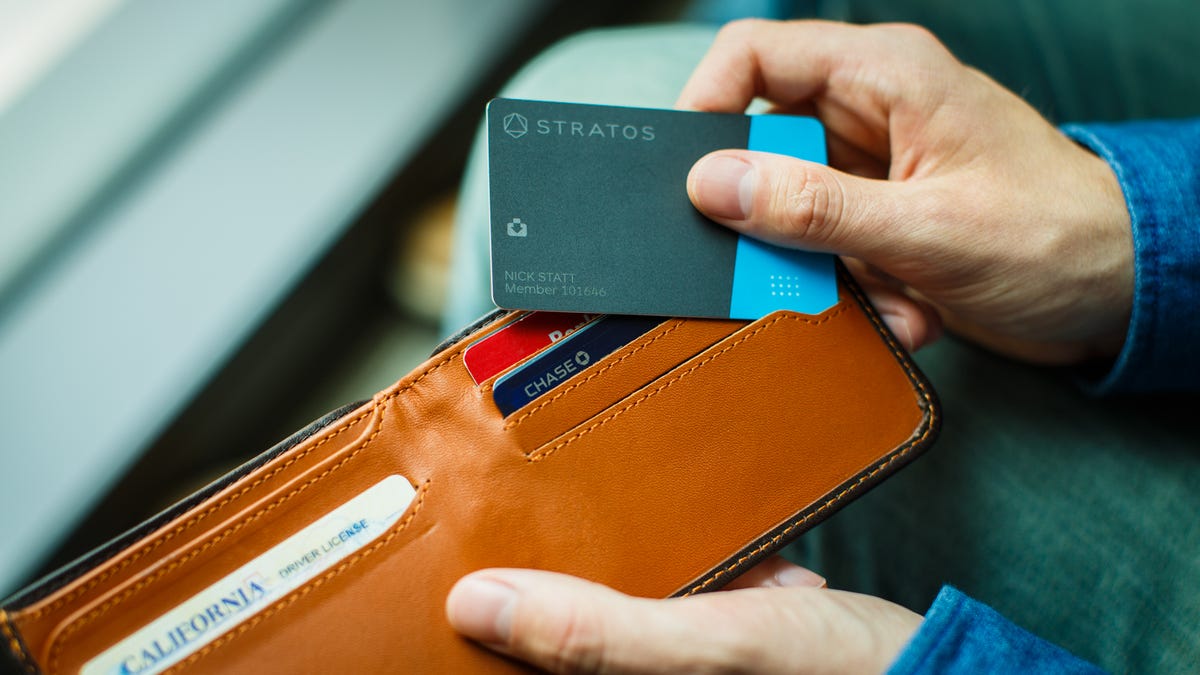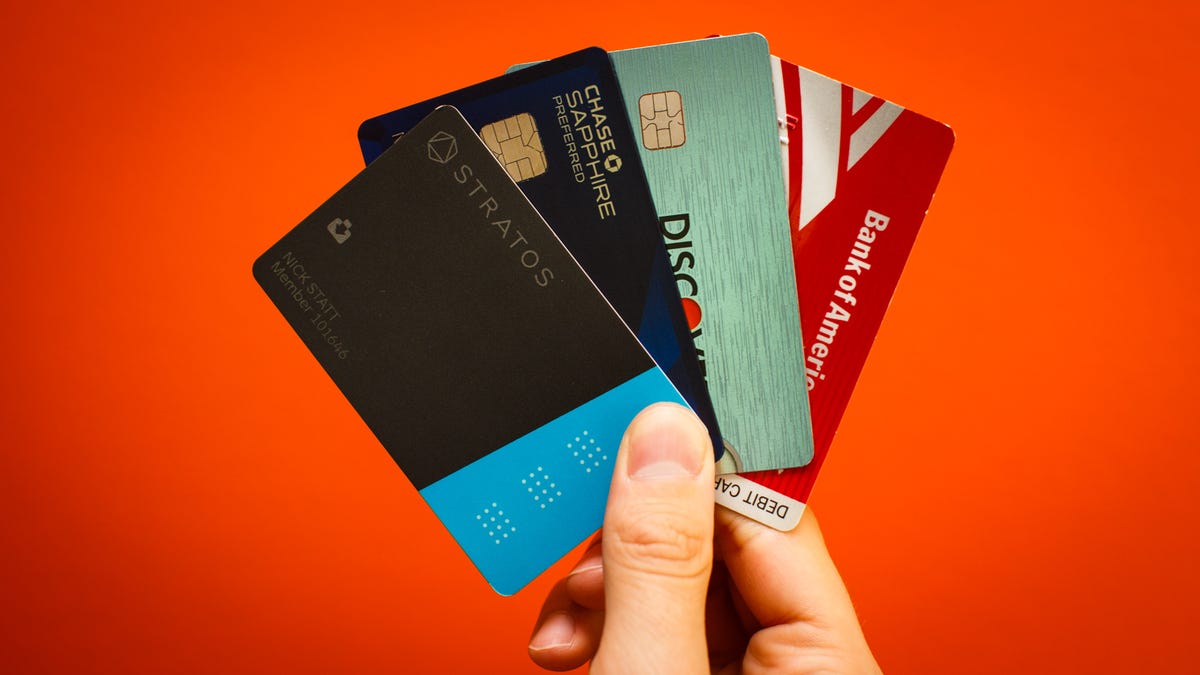
Josh Miller/CNET
With a Chipotle burrito in one hand, I handed the cashier a credit card lined with miniature computer parts.
She handed it right back.
“We only take Visa and MasterCard,” she said, puzzled by my Stratos card, which holds multiple credit and debit cards in the magnetic stripe running across its back. The trouble is, the card doesn’t display any official logos, giving it the look of an attractive scam. She swiped the Stratos after I convinced her it actually held a Visa. The word “approved” flashed in blue across her terminal screen.
Paying with a Stratos may not be as seamless as holding your iPhone near the register and using Apple Pay. Apple’s mobile payments service lets iPhone 6 and iPhone 6 Plus owners use their smartphones and their fingerprints to charge purchases to their credit cards just by holding their iPhone near a terminal. And while technologists rejoice at Apple Pay’s security, only 6 percent of iPhone 6 and iPhone 6 Plus owners used Apple Pay as of March, according to market researcher InfoScout.
Now so-called smart cards like Stratos, Coin, Plastc and Swyp have come on the scene. When coupled with a smartphone app, these devices — which cost around $100 — let users store and toggle among different payment cards on the fly. Cards are scanned in using a small card reader and managed with a smartphone app. Their pitch: A single all-purpose solution that melds modern networking and payments technologies for mainstream consumers.
That is, until the financial infrastructure catches up with Apple Pay, Google Wallet and other digital payments systems.
That’s because consumers and businesses still rely on credit card technologies and financial networks implemented decades ago. Credit and debit cards, and the terminals that accept them, are ubiquitous. Kiosks that work with Apple Pay or any competitors, are not.


Josh Miller/CNET
“There’s this chicken and egg problem,” said Thiago Olson, CEO of Stratos, based in Ann Arbor, Mich. According to Olson, mobile payment companies design products that few can use because a small minority of merchants will accept that. That, in turn, means few consumers adopt the new technologies.
Just ask Square, the payments company headed up by Twitter co-founder Jack Dorsey. The company continually rebrands various software efforts, like Square Wallet and Square Order, as it tries to get consumers to pay with their smartphones. Square declined to comment for this story.
“Using this card [Stratos] is a way to immediately link your smartphone to the current infrastructure,” Olsen said.
Greg Rosen, an investor at New York-based venture fund Box Group, shares that point of view. Although he was an early preorder customer of Coin, which originally launched in November 2013, Rosen just got his hands on the finished product. He’s used the card for three weeks now without any hiccups.
“It would be awesome if every single merchant took Apple Pay,” he said. But that’s not the reality. “It’s kind of crazy that we’re in 2015 and we’re still paying with cash and plastic, and we have a computer in our pocket.” Until the computers in our pocket become the main way to pay, he has a Coin card.
Future-proof?
The question facing Stratos and companies like it is whether these smart cards are detours in the mobile payments evolution (detractors call them solutions in search of a problem), or are practical products that can survive as the world transitions to digital payments?
“Apple Pay has paved the way for the connected card,” said Jason Townsend, a partner at Ann Arbor, Mich.-based Resonant Venture Partners, a Stratos investor. “The whole point of a mobile payments solution is that I can use it everywhere. If I can’t use it everywhere, then I still need my wallet and what’s the point?”
Forrester analyst Sucharita Mulpuru is skeptical. “The only problem [smart cards are] addressing is a fat wallet full of cards,” Mulpuru, an expert in e-commerce, said. “Is that really that big of a problem?”
Still, Mulpuru doesn’t expect people to exclusively use their smartphones and mobile payments systems for at least a decade. But she does think the mobile payments space is poised on the edge of more substantial change.


Josh Miller/CNET
That’s because EMV, or the EuroPay Mastercard Visa standard, is expected to spread throughout the US credit card industry by the end of the year. EMV promises greater security through small microchips embedded in plastic. While Europe has had the technology for years, the US pushed for the technology only after high-profile hacks on Target and other retailers.
By October 2015, merchants that haven’t upgraded their terminals to accept the new cards will be the ones liable for fraud, not the credit card companies. The result: we’ll start to see many more EMV-ready point-of-sale (POS) systems.
That’s a problem for Stratos, Coin and their rivals.
“If you have a chip in your card, the POS system is going to prompt you to put your card in the [chip] slot,” Mulpuru said. That becomes a problem with products like Stratos, which do not contain chips. That means you’ll still need to carry around a backup card.
EMV is also inherently more difficult to replicate than a magnetic stripe, and Stratos and its competitors have struggled to incorporate the technology into their first-generation products. Coin, which is the only other smart card shipping today, does not have EMV capabilities. Both companies plan to incorporate the technology into future products.
Plastc and Swyp, due out later this year, expect to be EMV-compliant. Plastc will include an EMV chip in its universal card while Swyp says it will provide an “over the air firmware upgrade.”
But EMV cards in the US will differ from those in Europe in one notable exception: Instead of the highly secure chip-and-pin cards used throughout Europe, US consumers will use chip-and-signature cards. That distinction is why James Lynch preordered Stratos this month. An Ireland native, Lynch says he’s used chip-and-pin cards for around a decade, and the US’s relatively lax security measures made him uneasy when he moved to California last year.
“Purchasing Stratos mitigates some of this worry,” he said.
What’s more, Stratos, Coin and their rivals don’t directly store credit or debit card information unencrypted — and only transmit sensitive data from your smartphone. That makes devices inherently more secure than the standard magnetic stripe credit card. There are also options to deactivate the card if it loses communication with your phone.
Still, the arrival of EMV-ready terminals poses another hurdle for smart cards: those very same POS systems will likely be outfitted to handle Apple Pay, Samsung Pay, Google Wallet and other technologies that rely on so-called near-field communication, or NFC. As NFC terminals proliferate, Apple and its mobile payments rivals will become more popular.
But not for a while.
“The longer-term viability of a physical card is up for debate, but for the short- and medium-terms, NFC phone tech solutions are not going to put cards out of business completely,” said Lynch. And he’s right.
Forrester estimates that in-person mobile payments — which do not include those made on the phone during online shopping — hit $3.4 billion in the US last year, or one quarter of 1 percent of total annual retail spend. But they’re growing fast and are expected to hit $34 billion by 2019.
“The media frenzy around mobile payments — most recently Apple Pay — has reached fever pitch and led some industry spectators to conclude that a payments revolution is at hand. Not so,” Denée Carrington, a former senior analyst at the firm, wrote in November 2014. “The adoption of mobile payments is an evolution — not a revolution — and the evolution is well underway.”
Pending payment wars
Perhaps the biggest threat to the smart card is simply the dizzying number of solutions trying to make physical credit cards obsolete altogether.
Samsung offers Samsung Pay for its Galaxy S6 phones. Samsung also owns the technology behind LoopPay, acquired in February, that lets you replicate a magnetic card swipe with either a phone case or a keychain fob. There’s also Android Pay, a new Google-owned payments platform that will soon power its Google Wallet service.
The credit card industry doesn’t appear to care which wins out, however.
That’s because credit cards don’t go away. They just end up in different devices, such as phones, dongles, watches or smart cards, said Sam Shrauger, Visa’s senior vice president of digital solutions. Which form consumers pick doesn’t matter to Visa, which processes transactions through its electronic network — so long as it’s not cash.
“Our competition, so to speak, is paper,” he said, since that’s just about the only form of payment that doesn’t use a network like Visa’s. Some consumers will opt to use several devices, while others may depend on only one.


Josh Miller/CNET
Because they work with the current payment infrastructure, companies like Stratos hope they can move wherever the industry takes them.
Olson said he envisions working with Visa and others to issue their own branded smart cards. Stratos currently offers a $100 annual subscription service so customers who sign up can receive cards with newer technology a flat rate every year. Olson hopes to expand the service alongside the app into a money management program that will help consumers manage their finances.
One suggestion: A way to trigger the right card to maximize rewards points when you’re, say, at the movies, booking a hotel or buying plane tickets.
Ideally, Stratos could move into providing a platform for what Olson calls virtual cards. Instead of being issued new loyalty, credit or debit cards, companies down the line may be able to generate virtual cards that load directly into Stratos’ app. Then with just a tap, the card could be ready for use on Stratos, which he hopes will have biometric fingerprint reading technology in the future.
Even so, Stratos and others could face a hard sell.
“This could have taken off a couple of years ago,” said Mulpuru. “They’re a day late and a dollar short. The industry has completely changed.”
CNET’s Ben Fox Rubin contributed to this report.




